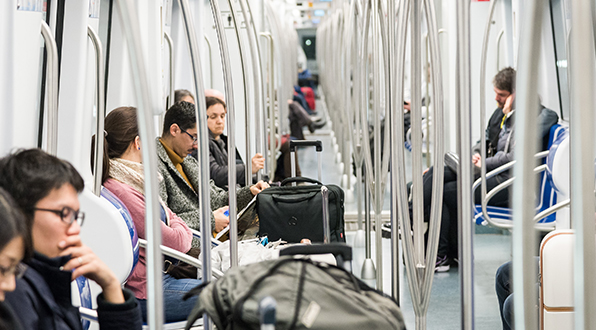What's an automated metro?
How does an automated metro work?
Advanced technology enables resources, facilities and line infrastructure to be operated remotely, including the trains, lifts and escalators, ticket machines and turnstiles.
The trains on automated lines have no staff on board: they are located, controlled and programmed from the control centre. Trains run at the assigned speed and stop at stations according to a pre-set schedule that may vary according to date and time, although the control centre can intervene at any time.
The Control Centre
This is the nerve centre of the metro network. Specialists in various areas of operation (safety, civil defence and information) work there and provide support for line staff.
The centre's operators monitor the trains at all times via remote control and can see inside them in real time through on-board cameras. They can also send and receive messages to passengers via the PA system and intercoms, and they can provide remote assistance.
The Control Centre constantly monitors the status of the network to be able to adapt supply to sudden increases in demand, putting on more trains when necessary and increasing frequency.
Automated trains
These trains are light in structure and feature advanced technology and considerable energy savings. Their modern interiors are adapted to the capacity, comfort and safety requirements. The fact that there is no cab means a new travel experience.
All the trains have active passenger information systems, such as light signals, internal PA system and emergency intercoms. They also incorporate a display system consisting of LCD screens and fire detection and video surveillance systems. All trains have an exit ramp at the front for use in an emergency.
Next-generation stations
The construction of stations was dependent on the subsoil conditions, intersections with other lines in the network and services, and the high level of urban development in certain areas.
All the stations are wheelchair adapted and most have large-capacity lifts. Some stations have escalators for the general public and lifts for people with reduced mobility. At stations, passengers enter and exit trains through platform screen doors, which open and close in time with train doors to avoid intrusions or accidents.
What are the benefits of automated lines?
Automation of the metro marks the way to improved service. It not only increases the technical safety of the metro, but also increases train frequency, in complete safety and maximum regularity.
- Greater safety and reliability: cutting-edge technology to control and supervise the running of trains means a more regular and reliable service, while the likelihood of human error is reduced. All stations have platform screen doors to prevent people and objects from falling on the track.
- Greater flexibility and capacity: this management system means supply can be adapted to demand. Thanks to sophisticated control and monitoring systems, trains can run more frequently at peak times, that is, the network capacity can be increased and better adapted to respond to the needs of public mobility.


















